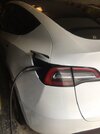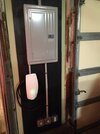When parking in a home garage, I wish the Tesla plug was
more inserted inside the door panel,
or that
the plug was more flatter, because the space between the wall and the car is often small
especially for older garages, when you already have to park the passenger side close to the wall.
So when carrying items to or from the trunk or carry outside the trash, I often it the charging plug.
In my case,
having the cable coming from above and suspended above the charging door,
provided more room and less risk of hitting the cable on the floor, especially for younger kids.
See what
plug shape would have been
less intrusive when parked in a narrow garage.
Maybe someone like
EVSE could make an adapter extension with such shape?
View attachment 982367 View attachment 982368







